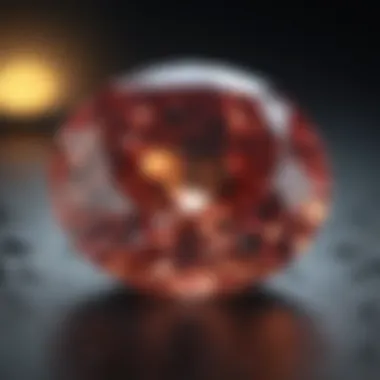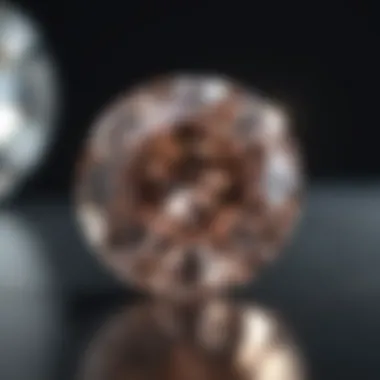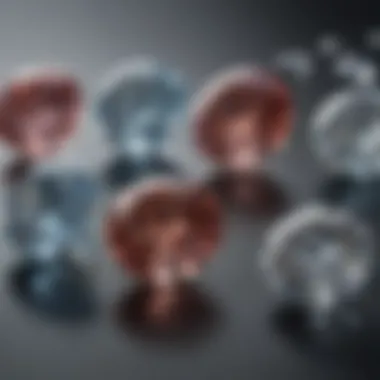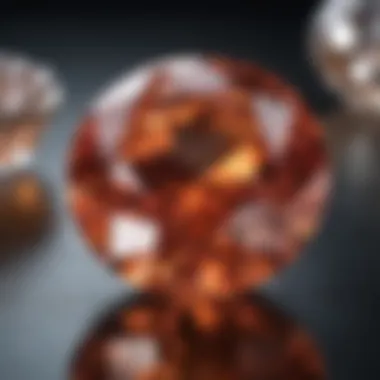Choosing the Ideal Color and Clarity for Round Diamonds


Intro
Round diamonds are among the most coveted gemstones, renowned for their brilliance and fire. When considering a purchase, two primary factors that come into play are color and clarity. Understanding these elements is essential for individuals seeking to make a wise investment or to select the perfect piece for personal adornment. This article will illuminate these factors and their implications on a diamond's value and appearance.
Gemstone Overview
Definition and Characteristics
Diamonds are crystalline forms of carbon with extraordinary hardness and optical properties. Their structure allows light to enter, reflect, and disperse, creating a captivating blend of colors and brightness. Round diamonds, specifically, are cut in a circular shape, which is designed to maximize brilliance. Their classic cut style appeals to a wide range of buyers.
Classification of Gemstones
Gemstones are typically classified based on their chemical composition, origin, and value. When it comes to diamonds, grading involves two major aspects: color and clarity. These aspects significantly influence how a diamond is perceived in both aesthetic and monetary terms. In the world of gemstones, diamonds hold a prominent position due to their rarity and the rigorous processes involved in their grading.
Historical Significance
Ancient Uses and Cultural Importance
Throughout history, diamonds have not only served as ornamental pieces but also held symbolic meanings in various cultures. Ancient civilizations believed diamonds possessed mystical powers, associating them with protection and strength. During the Middle Ages, they were thought to be antidotes to poison and were used in royal jewelry, symbolizing power and wealth.
Myths and Legends Surrounding Gemstones
Many myths surround diamonds, such as the notion that they can bring good fortune or ward off evil. Their brilliance has inspired numerous legends, often linked to love, commitment, and eternal bonds. Such narratives have solidified their place in cultural traditions, particularly in the context of engagement rings.
"Understanding the nuances of diamond color and clarity can significantly impact your purchasing decisions and the overall appreciation of this timeless stone."
By examining the color and clarity components, buyers can make informed decisions that align both personal taste and market standards. The subsequent sections will elaborate on grading scales, optimal grades for various buyers, and how these characteristics ultimately shape the overall appearance of round diamonds.
Foreword to Round Diamonds
Round diamonds are among the most popular cuts when it comes to engagement rings and fine jewelry. Their brilliance and timeless appeal make them a favored choice for those seeking a meaningful piece. The shape offers a symmetrical design that maximizes light return, creating an enchanting sparkle that captures attention. Understanding the characteristics of round diamonds is essential for both buyers and enthusiasts.
When discussing round diamonds, one must consider various factors that influence their appearance and value. Central to this discussion are the concepts of color and clarity. These components not only impact the beauty of the stone but also shape its market value. Buyers often list these traits as key considerations when selecting a diamond.
Moreover, appreciating round diamonds goes beyond their visual appeal. It involves recognizing the craftsmanship and the grading systems synonymous with quality assessment. The round diamond cut is designed to optimize the diamond's natural qualities, and when these diamonds are evaluated, the clarity and color grades play a crucial role in establishing their overall worth.
As this article progresses, it will elucidate the significance of color and clarity. We'll explore grading systems, ideal ranges within those systems, and how they affect both aesthetic and economic aspects of diamond purchasing. This knowledge empowers consumers to make informed decisions, ensuring that the chosen diamond not only reflects personal taste but is also a sound financial investment.
Understanding the Four Cs
The foundation of evaluating gemstones, particularly diamonds, relies heavily on a set of criteria known as the Four Cs: Carat Weight, Color, Clarity, and Cut. These elements are essential for understanding not only a diamond's intrinsic value but also its aesthetic appeal. In the context of round diamonds, these factors become even more critical due to their popularity and widespread use in various types of jewelry.
Understanding the Four Cs helps buyers to make informed choices based on the specific characteristics they prioritize. Recognizing the interplay between these elements can either elevate a diamond's beauty or diminish its overall desirability. For instance, a larger carat weight may not be as impressive if the color and clarity are not up to par. Each of these criteria contributes uniquely; thus, a comprehensive understanding is crucial.
Carat Weight
Carat weight measures a diamond's size. One carat equals 200 milligrams. Larger diamonds are generally more valuable, but carat weight alone doesn't determine a diamond's price. The weight must be considered alongside the other Cs for a full picture. For instance, a two-carat diamond that lacks color and clarity may be priced lower than a smaller diamond with superior quality.


When selecting a round diamond, individuals should assess how carat weight aligns with their budget and the diamond's intended purpose. Personal preference often influences this choice, whether for a simple ring or an elaborate piece.
Color
Color is a significant factor that impacts a diamond's appearance and value. The Gemological Institute of America (GIA) grades diamond color on a scale from D (colorless) to Z (light yellow or brown). Colorless diamonds, such as D, E, and F, tend to be the most sought after and are more valuable. As one moves down the scale, the presence of color becomes more pronounced, which can lower the price.
Ideal choices for round diamonds typically fall within the G to J range. These diamonds offer a near-colorless look, striking a balance between visual appeal and value. It is essential to consider how the diamond will be viewed. Certain settings or lighting may enhance or detract from color, making this a nuanced choice.
Clarity
Clarity refers to the presence of internal or external blemishes in a diamond. It is graded on a scale from Flawless (no inclusions visible under 10x magnification) to Included (inclusions visible to the naked eye). The clarity grade can significantly affect the perceived quality and the price of the diamond.
For round diamonds, clarity is a key consideration. A clarity grade of VS1 or VS2 is often ideal, as these diamonds have minor inclusions that are not detectable without magnification. Buyers who prioritize clarity may choose to spend more for higher grades to ensure that their diamond sparkles without noticeable flaws.
Cut
Cut grade assesses how well a diamond's facets interact with light. This element directly influences a diamond's brilliance and sparkle. The cut grade ranges from Excellent to Poor. A well-cut diamond can appear larger and more dazzling, regardless of its carat weight, color, or clarity.
The round cut, also known as the brilliant cut, is particularly popular due to its ability to reflect light effectively. It's essential to look for diamonds with an Excellent or Very Good cut grade. Investing in cut quality can enhance the overall beauty of the diamond, making it stand out above others.
Ultimately, understanding the Four Cs enables buyers to make choices that aligns with their values and preferences. Each aspect contributes to the overall quality and appeal of round diamonds, influencing both enjoyment and investment value.
The Importance of Color in Round Diamonds
Color plays a critical role in determining the overall beauty and desirability of round diamonds. Unlike any other gemstone, diamonds exhibit a unique brilliance and fire, qualities that are intricately tied to their color. A diamond’s color can significantly influence its perceived value, as well as how it complements various settings and personal styles. Whether it is for an engagement ring or an item of luxury jewelry, understanding the color of round diamonds is crucial for discerning buyers.
When assessing a diamond, the color serves as one of the primary factors influencing decision-making. A diamond that is graded too high or low on the color scale can have marked effects on its price and aesthetic appeal. For example, diamond color can subtly shift how a diamond interacts with light. Thus, appreciating the nuances in color grading will help potential buyers make informed choices that align with their personal tastes and the market standards.
Some important aspects to consider include:
- Market Value: A diamond's color impacts its market value directly. Diamonds with less color are often more highly sought after.
- Personal Preference: Individual preferences vary widely. Some buyers may prefer colorless diamonds, while others find beauty in faintly tinted stones.
- Compatibility with Settings: The setting of the diamond can enhance or dull the overall color effect. Understanding this relationship can guide better purchasing decisions.
The importance of color goes beyond aesthetics; it also underpins the market's perception of a diamond's worth, thus influencing procurement strategies for collectors and jewelers alike.
Color Grading System
The color grading system for diamonds utilizes a scale developed by the Gemological Institute of America (GIA). This scale judges a diamond's color on a range from D to Z.
- D: Completely colorless, the highest grade.
- E-F: Colorless to near-colorless, slight traces of color can exist but are not visible.
- G-H: Near-colorless with slight color visible under certain conditions.
- I-J: Slightly tinted and may show color more prominently.
- K-Z: Increasingly tinted diamonds, with noticeable color as you progress down the scale.
Grading takes into account not just the presence of color but also its tone and saturation. Jewelers and gemologists utilize controlled lighting conditions and specialized tools when assessing a diamond's color to ensure accurate grading.
Ideal Color Range for Round Diamonds
For most buyers, the ideal color range is typically considered to be from D to H. Diamonds in this range offer a superb balance between beauty and value:
- D-E: These colorless options command high prices and are often chosen for their ultimate clarity and brilliance.
- F: Often viewed as one of the best values in the colorless range, it provides minimal color impact while maintaining a high visual appeal.
- G-H: Still near-colorless, diamonds in this range are seen as great options for those who want elegance without high costs.


Choosing a diamond from this ideal color range ensures that the diamond emits maximum fire and brilliance while remaining widely accepted in the market as attractive and valuable. Ultimately, buyers should decide which color range resonates most with their personal taste, the intended purpose of the diamond, and their budget.
Exploring Diamond Clarity
Diamond clarity is a substantial factor in determining the beauty and value of round diamonds. Clarity refers to the presence of internal or external flaws, often called inclusions and blemishes, respectively. These characteristics can significantly impact how light interacts with the stone, thus influencing its sparkle and overall appearance. In the buying process, clarity becomes essential, as it helps in establishing not only the quality of the diamond but also its market value.
For gemstone enthusiasts, understanding clarity is vital in distinguishing between various diamond options. A diamond with higher clarity tends to be more visually appealing, drawing attention for its brilliance. Also, diamonds with better clarity grades often hold more value, making them desirable for collectors and investors alike. This section will detail the clarity grading scale, providing insights into how to evaluate diamonds effectively.
Clarity Grading Scale
The clarity grading scale is established by the Gemological Institute of America (GIA) and ranges from Flawless (FL) to Included (I). Here’s a brief overview:
- Flawless (FL): No inclusions or blemishes visible under 10x magnification.
- Internally Flawless (IF): No inclusions visible under 10x magnification, but may have insignificant surface blemishes.
- Very Very Slightly Included (VVS1 and VVS2): Inclusions that are difficult to detect under 10x magnification.
- Very Slightly Included (VS1 and VS2): Minor inclusions that are visible under 10x magnification but are minute.
- Slightly Included (SI1 and SI2): Inclusions that are noticeable under 10x magnification and may be visible to the naked eye.
- Included (I1, I2, and I3): Inclusions that are obvious and may affect transparency and brilliance.
This scale allows buyers to compare diamonds easily. Each grade highlights the potential impact of flaws on the diamond's aesthetic appearance. Understanding this scale provides buyers with critical knowledge when making purchasing decisions.
Best Clarity Options for Round Diamonds
When selecting round diamonds, clarity should be balanced with personal preference and budget. Generally, diamonds graded from VS2 to SI1 are considered excellent choices for value without significantly compromising beauty.
- VS1 and VS2: These clarity grades offer minimal inclusions that are hard to spot, ensuring that the diamond remains eye-catching while still being budget-friendly.
- SI1: This grade may show inclusions visible to the naked eye but is often a good choice if the diamond is set in a unique way that masks imperfections.
- VVS1 and VVS2: Ideal for those wanting high clarity that remains visually spectacular. However, they can come with a higher price tag.
The Relationship Between Color and Clarity
When selecting a round diamond, understanding the intricate relationship between color and clarity is essential. These two characteristics significantly influence a diamond's beauty and value, guiding buyers in making informed decisions. Both traits can complement or detract from one another, making their relationship fundamental to the overall aesthetic appeal of the gemstone.
How Clarity Affects Perceived Color
Clarity directly impacts how color is perceived in a diamond. A diamond with fewer inclusions or flaws allows light to travel through it more efficiently, enhancing its brilliance and sparkle. On the contrary, a diamond with many inclusions can trap light, leading to dullness—even if the color grade is high. This means that a well-cut diamond with high clarity can enhance the beauty of its color, making it appear more vibrant.
For instance, a Color G diamond with a clarity grade of VVS2 (Very Very Slightly Included) will reflect color more beautifully than a Color G diamond with a clarity grade of SI2 (Slightly Included) due to the presence of fewer visible imperfections.
Additionally, imperfections can cast shadows within the stone, which may alter the viewer's perception of the diamond's hue. Thus, buyers should prioritize clarity when assessing color, as the interplay between these factors can significantly affect the overall appearance of the diamond.
Color and Clarity in Different Lighting Conditions
Lighting plays a critical role in how both color and clarity are perceived within a diamond. Natural sunlight, fluorescent light, and incandescent light can each reveal different attributes of a diamond. For example, sunlight can reflect the most accurate depiction of a diamond's color, while fluorescent lighting tends to exaggerate color perception, making some hues seem more intense.
In various light settings, high-clarity diamonds will often display their color more accurately, whereas lower clarity may mask the actual color due to how light interacts with inclusions. This is why examining diamonds in multiple lighting conditions is necessary before making a purchase.
"Diamonds are like people; they show different aspects of themselves in different light. Understanding how your diamond behaves in various conditions is key to appreciating its true value."
Personal Preferences vs. Market Standards
The topic of personal preferences versus market standards is significant in the realm of round diamonds. Understanding this balance is crucial for consumers looking to make informed purchasing decisions. Diamonds, while they are graded based on objective criteria, are ultimately chosen by individuals based on a personal sense of beauty and worth. Each buyer's subjective taste plays a vital role in determining which color or clarity level appeals most to them.
One major element to consider is how individual taste can diverge from what is traditionally valued in the market. Preferences for specific hues or levels of clarity can vary greatly, influenced by culture, personal experiences, and even fashion trends. For example, while many buyers gravitate towards diamonds with perfect clarity and near-colorless ratings, others might find beauty in stones that possess unique color tints or slight inclusions. This subjectivity allows for personal expression in jewelry choices but can also lead to confusion in a market largely driven by universally accepted norms.


It is also important to note that market trends change over time. They are sometimes defined by influential designers or celebrities, creating outbreaks of popularity around certain diamond characteristics. Keeping track of these trends can help buyers align their personal preferences with what is currently valued in the market, ensuring that their choice does not just reflect personal taste but also has resell value in the event they decide to part with their gem in the future.
Ultimately, buyers should strive for a balance between their individual desires and the standards set by the market.
"Finding beauty in imperfection can be more rewarding than simply adhering to market expectations."
Understanding Individual Taste
Understanding individual taste involves recognizing the factors that influence each buyer's choice. Personal experiences and associations play a considerable role. Someone who has an emotional connection to a specific color may prioritize color over clarity. Similarly, values on sustainability can affect choices, as buyers might favor diamonds that come from ethical sources, regardless of specific grades.
Another aspect is the setting of the diamond. The way a diamond looks in a piece of jewelry can dramatically alter perception. A diamond with slight inclusions may look stunning in the right mounting, particularly if the design draws attention to its unique features. Therefore, buyers need to consider how their personal preferences mesh with the intended piece in which the diamond will be set.
Current Market Trends in Color and Clarity
Market trends in color and clarity continue to evolve, influenced by both fashion and technology. Currently, there is a notable appreciation for colored diamonds. Shades like vivid yellow or fancy pink are attracting buyers looking for uniqueness and distinction. As a result, the market has had to adapt, allowing for a wider acceptance of colored stones that were once considered less desirable.
In terms of clarity, the trend seems to be shifting towards a greater acceptance of minor inclusions. The rise of lab-grown diamonds has led consumers to reassess what "perfect" means in terms of clarity. Consumers are recognizing that clarity is not always synonymous with quality; some may prefer diamonds with personality.
Thus, it is essential for buyers to stay informed about current trends while also evaluating their personal preferences. To make the most of their investments, they must understand not just what they want but what others are currently valuing in the diamond marketplace.
Practical Tips for Choosing the Right Round Diamond
Choosing the right round diamond involves various considerations. Each diamond is unique, and factors like color and clarity play significant roles in its overall value and appearance. Therefore, understanding the intricacies is crucial not only for aesthetic appeal but also for financial investment.
Establishing a Budget
When it comes to diamonds, setting a budget is perhaps the first and most critical step to take. This process requires honesty about one’s financial situation and what one is willing to spend. Diamonds can range from affordable to extremely expensive, depending on their specifications, particularly their color and clarity.
- Understanding Pricing: Familiarize yourself with how color and clarity affect the price of diamonds. For instance, diamonds with higher clarity grades tend to cost more. Similarly, those with desirable color ratings also fetch premiums. Knowing this can guide where to allocate more of your budget.
- Prioritize Features: Decide what aspects are more important to you. Would you rather have a larger diamond with lower clarity or a smaller, higher-quality stone? This decision will influence how much you are prepared to spend.
Evaluating the Trade-Offs
In the quest for the ideal round diamond, trade-offs between color and clarity are common. Each buyer must weigh these trade-offs based on their personal preference and intended use, such as an engagement ring or a collectible.
- Balancing Act: Sometimes, a slightly lower clarity can allow you to afford a stone with better color. Alternatively, you might choose a diamond that is not perfect in color but fits into your desired clarity range. Evaluating trade-offs often comes down to individual taste and how each diamond looks to the naked eye.
- Return on Investment: Consider how future changes in the diamond's value might impact your purchase. Some buyers prefer to secure a balance that improves their investment potential. Understanding market trends can aid in making these decisions.
Consulting with Professionals
When selecting a round diamond, seeking expert advice is invaluable. Professionals in the jewelry industry can provide insights that enhance your decision-making process.
- Gemologists and Jewelers: Consult licensed gemologists or reputable jewelers. They can explain the grading systems and guide you in finding the best diamond within your budget. A knowledgeable jeweler can also help clarify why certain diamonds cost more and what specifics contribute to their value.
- Educational Resources: Utilize resources such as the International Gem Society or the Gemological Institute of America. These organizations offer information that helps demystify diamond attributes, empowering buyers in their purchase journey.
Seeking professional guidance is not just wise; it can save you significant amounts of money and prevent buyer's remorse.
With thorough understanding and consideration of these practical tips, buyers can make informed choices, ensuring satisfaction with their round diamond selection.
Epilogue
In the sphere of round diamonds, understanding the interplay between color and clarity is essential for any prospective buyer. This article underscores not only the significance of these characteristics but also their impact on the diamond’s overall value and aesthetic appeal. Grading scales provide a structured way to assess these qualities, helping buyers to make informed decisions.
Choosing the right color and clarity requires a careful evaluation of personal preferences alongside market standards. Often, collectors and enthusiasts find themselves navigating a spectrum of options, each presenting unique benefits and considerations. The ideal combination can enhance the diamond's brilliance and visual impact, ultimately resulting in a piece that fulfills both emotional and aesthetic desires.
Furthermore, this guide emphasizes practical tips for selecting a diamond that aligns with individual tastes and budgets. Establishing an appropriate budget, understanding trade-offs between color and clarity, and consulting professionals are pivotal steps in this journey.
Ultimately, color and clarity serve as the foundation for not just the diamond's appearance but also its long-term value. By grasping these concepts, buyers will be well-equipped to select a round diamond that not only satisfies their aesthetic expectations but also stands the test of time in both style and value. As such, this article contributes greatly to a comprehensive knowledge bank that any gemstone enthusiast or collector will find invaluable.







